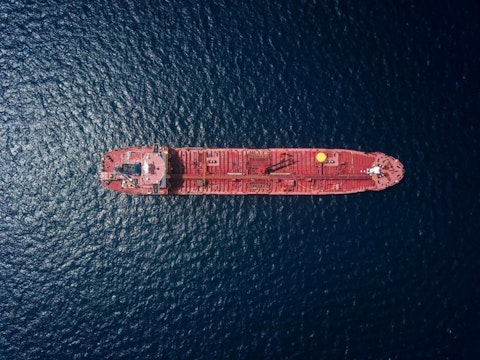In this article, we will look at the 10 major shipping routes for global trade in 2023. If you wish to see the top 5, head straight to the 5 major shipping routes for global trade in 2023.
It might not be the most glamorous industry, but if the shipping industry came to even a temporary halt, the global economy would suffer. Generally, there isn’t really a lot to hear in this respect as shipping tends to continue unimpeded, but the world received a taste of what could happen when the ship Ever Given got stuck in the Suez Canal, one of the major shipping routes for global trade in 2023. This ended up blocking the route and in just 6 days, according to Lloyd’s List Intelligence data, blocked around $10 billion worth of trade. This might seem like a huge amount at first, but it’s important to remember that shipping accounts for around 80% of world trade.
Currently, thing don’t really look amazing for the global shipping industry, and Fitch revised its rating for global shipping to deteriorating from neutral, as challenges continue to increase for an industry without which the global economy would falter. At the end of 2022, most organizations were feeling pessimistic about the shipping industry, with U.N. agency UNCTAD stating that the global shipping industry would falter amid economic turmoil and slower economic activity across the world. Economic growth has been hampered by various factors including higher inflation and higher interest rates, but geopolitical tensions and escalations have played their part too, with the Russia Ukraine war contributing to lower expectations from the global shipping industry.

Photo by Shaah Shahidh on Unsplash
The United Nations Conference on Trade and Development predicted that the global shipping industry growth rate would fall to just 1.4% in 2023, which would also impact the profitability and revenue of the major shipping routes for global trade, especially when compared to a growth rate of 3.2% in 2021. Unfortunately, even the long-term outlook isn’t especially favorable to the global shipping industry, as the expected growth rate from 2023 to 2027 is just 2.1% annually, significantly lower than the average annual rate of 3.3% growth over the last three decades. “The recovery in maritime transport and logistics is now at risk from the war in Ukraine, the continued grip of the pandemic, lingering supply-chain constraints, and China’s cooling economy and zero-COVID policy, along with inflationary pressures and the cost-of-living squeeze,” UNCTAD said in the report.
This negative sentiment has been reflected in the share price of some of the biggest shipping companies in the world. Maersk, one of the giants of the shipping industry, has seen its share price slide by over 28% YTD 2023. Maersk mentioned the challenges the shipping industry is facing in its Q2 2023 earnings call, stating “The volume and rate environment has developed as anticipated with inventory destocking continuing to be the primary driver for lower volumes, which could be felt in the performance of all our segments. A strong cost focus in ocean and terminal, in particular our caution the top line impacts and supported our bottom-line performance. In logistics and services, the impact of this normalization process was felt stronger than we had anticipated, resulting in growth below our expectations and higher cost, a transitionary situation we are in the process of correcting. While the first half year has developed essentially in line with our expectations, we do not see any sign of an expected volume rebound in the second part of the year. We are therefore reducing our full year outlook for global container volume. We now anticipate a range of minus 4% to minus 1% compared to our previous expectations of minus 2.5% to plus 0.5%, and we expect to perform essentially in line with this global growth.”
Similarly, ZIM Integrated Shipping Services Ltd. (NYSE:ZIM) has suffered an even bigger setback in its market cap, with its market cap declining by nearly 50% YTD 2023. Even though analysts had significantly lower expectations from the company’s performance in Q2 2023, ZIM Integrated Shipping Services Ltd. (NYSE:ZIM) came in even lower, with losses being twice as high as predicted, and resulting in the share price crashing, with the company mentioning the difficulties in the industry, and the limited impact mitigating strategies have had so far, stating “Alphaliner supply-demand outlook for 2023 and 2024 remains unchanged, pointing to clear oversupply. Slow steaming remains the most meaningful tool operators have consistently used in 2023 to absorb the oversupply created in the market with the complete unwinding of port congestions and new vessel deliveries. More recently, we have seen increased blanking, especially on Transpacific, which may have supported the recent rate increase on this trade. Other possible actions operators could have taken, namely idling or scrapping, have had a negligible effect so far. As the charter market remained relatively strong, the motivation to scrap old tonnage remains low. However, as chartered capacity comes up for renewal and IMO 2023 enforcement coming to play, the motivation to scrap may increase in 2024 and beyond. Delayed deliveries of new build capacity have also been minimal and are not expected to meaningfully impact the growth in supply. On the demand side, consumer spending remained relatively healthy despite rising inflation and greater macroeconomic risk, yet high inventory levels built over 2021 and 2022 and continued concerns over economic growth have caused importers to be cautious and limit any meaningful renewal of inventory.”
We mentioned earlier that conflicts are impacting the shipping industry and the recent war between Israel and Gaza has given rise to even greater risks for the shipping industry, including some of the major shipping routes for global trade in 2023. ZIM Integrated Shipping Services Ltd. (NYSE:ZIM) is one of the biggest Israel companies, and Israel’s risk rating is constantly undergoing change. Additional fees for war risk premium charges range from $50 to $100 per teu, which the company is transferring to customers. This may result in lower demand as higher prices could deter potential customers.
While the shipping industry outlook may not be as rosy as it used to be, the major shipping routes for global trade in 2023 are still extremely important for the global economy, and most shipping companies are investing in new tech and trends that are likely to shape the industry’s future. E-commerce is a driving factor behind greater demand for shipping and the global e-commerce logistics are expected to grow at a CAGR of 12% from 2020 to 2027, far outpacing the overall shipping industry growth. Additional trends including greater sustainability and eco-friendly shipping options, as ESG is now playing a major role for investors in deciding which companies to invest in.
Of course, perhaps the most important innovation in the shipping industry comes from the utilization of tech to improve forecasts and accuracy, and artificial intelligence is playing a massive role in this respect. Even minor details such as fuel usage and water traffic can result in monumental improvements to shipping efficiency, which is an extremely important aspect right now as costs continue to rise. Further, the usage of AI and machine learnings eliminates the possibilities of human error, which can then improve efficiency and reduce costs, resulting in greater profitability. Hapag-Lloyd, one of the largest shipping companies in the world, has recognized the importance of AI, and has a team located in Gdansk, Poland, which is using AI for the automation of processes, with one such implementation reducing the response time per email from 30 minutes to just three seconds.
Methodology
To determine the major shipping routes for global trade in 2023, we headed over to various websites with experience and expertise in the shipping industry, including Sinay, Freightify, Arc Beast and Maritime Page. The rankings are based on the average ranking from these four sources. Of course, the major shipping routes are also some of the busiest shipping routes in the world, and hence, are directly connected to the global economy.
10. Strait of Gibraltar
The Strait of Gibraltar connects the Mediterranean Sea to the Atlantic Ocean and separates Africa from Europe. Spain and Morocco, at opposite ends of the narrowest section of the strait, have been in discussions for decades for the creation of a tunnel across the strait.
9. The Danish Straits
The Danish Straits form one of the major routes for global trade in 2023, and connect the Baltic Sea to the North Sea. Denmark, Sweden and Germany share the ownership of the waterways.
8. Bosphorus Strait
Turkey’s location at the edge of Asia and Europe has given it significant strategic important, and the Bosphorus Strait in the country connects the Sea of Marmara to the Black Sea. Istanbul, the country’s capital is also located at the edge of the strait and its importance has seen Turkey and the UAE enter discussions to building a railway.
7. St. Lawrence Seaway
The St. Lawrence Seaway connects primarily the U.S. and Canada, and while not a continuous canal, it still one of the most important and major shipping routes in the world. Recently, a strike halted all shipping on the seaway after workers with Canada’s largest private-sector union went on strike, crippling a route which carried more than $12 billion worth of goods just last year alone.
6. Strait of Malacca
The Strait of Malacca is a stretch of water between the Malaysia Peninsula and Sumatra Island, which connects the Andaman Sea and the South China Sea. One of the most important shipping lanes globally, India is also looking to develop the strategically located Sabang Port in Indonesia, which will give it easy access to the Strait of Malacca.
Click to continue reading and see the 5 Major Shipping Routes for Global Trade in 2023.
Suggested Articles:
- 12 Best Places to Retire in Netherlands
- 12 Most Popular Food Delivery Services in the US
- US Alcohol Exports by Country: Top 15
Disclosure: None. 10 major shipping routes for global trade in 2023 is originally published on Insider Monkey.




